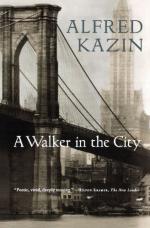
|
| Name: _________________________ | Period: ___________________ |
This test consists of 15 multiple choice questions and 5 short answer questions.
Multiple Choice Questions
1. Who did the author say it was good to be back among?
(a) His family.
(b) The children playing handball on the street.
(c) The women who shouted from the market.
(d) The children playing stickball on on the block.
2. When the narrative begins, how many years has it been since the author left to live in "the city?"
(a) Three Years.
(b) Ten Years.
(c) Five Years.
(d) Thirteen Years.
3. What belief about Jews did the author grow up with?
(a) That they were destined to be propertyless workers.
(b) That they were destined to marry only out of duty.
(c) That they were destined to be leaders of the country.
(d) That they were destined to be bankers.
4. Did the author's mother believe her son's generation would succeed?
(a) Yes.
(b) She thought that if they didn't follow the traditions, they would fail.
(c) She felt that Socialism would lead everyone to succeed.
(d) No.
5. The author's childhood school is still standing in the neighborhood, how does the school feel to the author?
(a) Cold and damp.
(b) Like a castle.
(c) Like a hospital.
(d) Like home.
6. What trait did the author's mother posses that she was most ashamed of?
(a) She had a limp on her right side.
(b) She was superstitious.
(c) She couldn't speak English.
(d) She had a large scar on her hand.
7. What did the team receive if they won the competition between the "Army Navy" tests the civics teacher gave?
(a) A gold star.
(b) An automatic passing grade on a test.
(c) A free pass to the bathroom.
(d) A blue star.
8. During his childhood subway train rides to "the city," what told the author that he was on his last leg home?
(a) The Borough Hall Station.
(b) The east and west side express lane junctions.
(c) The East River.
(d) The Brooklyn-Clark Station.
9. What is the name of the second road the author mentions?
(a) Market Street.
(b) Pitkin Avenue.
(c) Broadway Street.
(d) Hampton Avenue.
10. What instrument did the author play as a child?
(a) The violin.
(b) The piano.
(c) The clarinet.
(d) The trumpet.
11. What did the women of Brownsville force their children to do?
(a) Eat.
(b) Stay outside until dinner was ready.
(c) Shop for dinner.
(d) Beat rugs on the stoop.
12. What did the children buy from the small Italians?
(a) Sodas.
(b) Strawberries.
(c) Shaved Ice.
(d) Pasta.
13. In Brownsville, what room of the house was the largest and most important?
(a) The living room.
(b) The entry hall.
(c) The kitchen.
(d) The bathroom.
14. In front of what building did the author's father meet every Saturday morning?
(a) The coffee shop.
(b) The delicatessen.
(c) The hardware store.
(d) The Municipal Bank.
15. To the author's mother, what was the gateway to romance?
(a) Religion.
(b) Status.
(c) Fashion.
(d) Riches.
Short Answer Questions
1. What were the author's lasting feelings about his school years?
2. What physical trait was the author most embarrassed by during his early school years?
3. Where was the author's father offered a homestead while he was working for the Union Pacific Railway?
4. How did the author's parents feel of his generation?
5. What still lines Belmont Avenue that was there during the author's childhood?
|
This section contains 533 words (approx. 2 pages at 300 words per page) |

|




